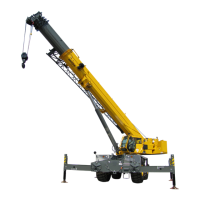National Crane 01-22-2019 Control # 051-08 2-5
1300A HYDRAULIC SYSTEM
7. Disconnect the return line from an outrigger extension
cylinder and fully extend the outrigger.
8. Connect the outrigger return line and retract the
outrigger. Replenish the reservoir hydraulic oil level as
necessary.
9. Repeat Steps 7 and 8 for the remaining outriggers.
10. Disconnect the return lines from a pair of outrigger jack
cylinders and activate the cylinders to their maximum
down positions.
11. Connect the return lines and raise the outrigger jack
cylinders to the stowed position. Replenish the reservoir
hydraulic oil level as necessary.
12. Repeat Steps 10 and 11 for the remaining two outrigger
cylinders.
13. Disconnect the return line from the telescope cylinder
and fully extend the boom.
14. Connect the return line and retract the boom. Replenish
the reservoir hydraulic oil level as necessary.
15. Disconnect the return lines from steer cylinders and turn
the wheels to the extreme right.
16. Connect the return lines and turn the wheels to the
extreme left and then back to center. Replenish the
reservoir hydraulic oil level as necessary.
17. Raise the crane on outriggers.
18. Disconnect the return line from the main hoist motor and
fully hoist up the hoist.
19. Connect the return line to the main hoist motor and fully
hoist down the hoist, then hoist up again. Replenish the
reservoir hydraulic oil level as necessary.
20. Disconnect one of the lines from the swing motor and
drive the motor in the direction it will go.
21. Connect the line to the swing motor, then drive the swing
motor in the opposite direction until the boom is centered
and forward. Replenish the reservoir hydraulic oil level
as necessary.
When hydraulic oils are changed, recheck the reservoir
hydraulic oil level after brief system operation and add
hydraulic oil as required. Ensure the crane is level and in the
travel mode of operation when the hydraulic system is being
filled. The system must be filled with all cylinders retracted.
Fill the reservoir to the full mark on the reservoir sight gauge.
After the reservoir is filled, operate all circuits and recheck
the reservoir sight gauge. Add hydraulic oil as required.
Removing Air From the Hydraulic System
Air entering the hydraulic oil will normally be removed
automatically by passage of the hydraulic oil over the baffles
in the hydraulic reservoir. If a component has been replaced,
the reservoir level is too low, or a leak develops in the suction
lines to the pumps, air can enter the system. If air becomes
entrapped in the hydraulic oil, it may be detectable in pumps
and motor operated components such as the swing
mechanism and hoist(s), because it can cause these units to
become noisy during operation. If noisy operation occurs,
first check the level of the hydraulic reservoir and replenish
as necessary. Then inspect for leaks in the suction lines
leading to the pumps.
Minute leaks may be hard to locate. If a leak is not readily
detectable, use the following way to check for it:
• Seal all normal openings in the hydraulic system and the
reservoir. Using a positive means to control the pressure
(like a regulator), pressurize the hydraulic system to
0.138 to 0.276 bar (2 to 4 psi) and inspect all joints and
fittings for evidence of leaks. A soap solution applied to
the fittings and joints may also prove helpful in detecting
minute leaks while the system is pressurized. Remove
the pressure, repair any leaks found, and reopen any
openings (such as a vent) closed for inspection. Refill
the reservoir after completing any repairs or service.
Operate all hydraulic circuits several times in both
directions.
• This action should return any entrapped air to the
reservoir where it can be removed from the hydraulic oil
by the baffles.
CAUTION
When draining the outrigger cylinders, always operate
either both front or both rear cylinders together to prevent
twisting the crane.
CAUTION
When hydraulic oils are changed or added, ensure that
hydraulic oils of different manufacturers are of the same
specifications, however, discoloration (milkiness) may
occur. Mixing incompatible hydraulic oils may result in
improper operation or damage to the machine.

